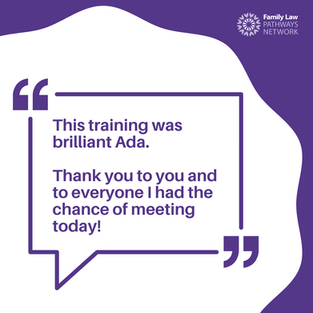Event Report: Resisting Collusion with Male Perpetrators (online training)
- Jane Holford
- Dec 1, 2020
- 4 min read
Updated: May 26, 2022
Date: 17 November 2020 and 1 December 2020 Time: 9:00 AM – 1:00 PM AEDT Venue: ZOOM Trainer: Ada Conroy of the Northern Integrated Family Violence Services
Price: $25 per ticket

Summary:
The Victorian Family Law Pathways Network – Greater Melbourne approached the Northern Integrated Family Violence Services (NIFVS) to host it’s ‘Resisting Collusion with Male Perpetrators’ online training to our members across two sessions, 17th November 2020, and 1st December 2020.
Each offering of this training was capped at 30 participants. This was to ensure that participants could actively participate in each training session within the allotted time. Participants were required to have access to a working camera and microphone to access the training for the purposes of group work and conversation.
Participants were given the opportunity to watch a pre-recorded webinar by NIFVS entitled ‘Responding to Family Violence during COVID-19’.
The training content:
Participants were encouraged to view the 75-minute session presented by NIFVS entitled ‘Responding to Family Violence during COVID-19’.
This session supported practitioners to:
· Identify family violence in the COVID-19 context;
· Develop strategies to establish safety using technology;
· Partner with victim survivors to undertake effective safety planning;
· Explore and undertake self-care; and
· Stay up to date with changes in the service system.
The webinar was incredibly useful for practitioners who come across adult victim survivors of family violence in the course of their work.
The Resisting Collusion with Male Perpetrators training was a half-day interactive online workshop. The training was designed for practitioners who may come across male perpetrators in the course of their work – it is important to note that this training was not men’s behaviour change facilitator training.
The day’s learning outcomes for participants was to be able to effectively identify and respond to men who cause family violence harm, by learning how to identify and resist invitations to collude. The training was divided into sections as described below.
The Context of Family Violence
The webinar began with a brief revisiting of the following prior learnings in the context of family violence:
· The gendered nature of family violence;
· The social context necessary for family violence to occur;
· Intersections of discrimination that perpetuate barriers to justice, safety and recovery for victim survivors; and
· A general understanding of the CRAF (common risk assessment framework) and/or MARAM (multi-agency risk assessment and management framework).
Through discussion and interactive group work, participants identified gender inequality as setting the necessary context for family violence to occur. In addition to gendered drivers, the group identified the following drivers of family violence as reflective of structural inequality:
· Colonisation;
· Racism;
· Ableism;
· Classism;
· Ageism;
· Homophobia;
· Biphobia; and
· Transphobia.
Accountability
Participants were ‘moved’ into break-out rooms – where the Zoom meeting allocates small groups to be able to talk away from the larger groups. The purpose of this group activity was to discuss what perpetrator accountability means, and how it differs from perpetrator responsibility. This activity gave the groups a chance to reflect on accountability in a broader context, rather than focusing on accountability specifically to a victim-survivor.
Core beliefs
The group was taught about the core beliefs held by men who use violence:
· Male entitlement –
Male entitlement is the conviction that men are owed something by virtue of their gender. It is the belief structure that tells men they deserve to have their whims catered to both culturally and interpersonally.
· Victim stance –
When these perceived slights are not met, perpetrators can feel like a victim. A ‘victim stance’ is a righteous moral position whereby he feels that he is always right, and any challenge to this authority causes him to feel victimised. This response is met with behaviours that are controlling, frightening, silencing and dangerous for the women and children.
· Violence Supportive Attitude –
This is an attitude that support, trivialises or condones violence against women, by excusing or minimising men’s use of violence or control, or by blaming other factors.
Challenges and Opportunities
Following on from the group discussion about core beliefs, participants were put back intot small breakout rooms to discuss the challenges and opportunities that arise when working with male perpetrators.
An example of what was discussed is as follows:
Challenges
Invitations to collude
Aggressive or intimidating behaviour
Charming behaviour
Opportunities
Prioritising the safety of the victim/s
Consult with a specialist men’s family violence service
Keep the perpetrator in view
Collusion
The group was then brought back together to receive specialist training on how to identify invitations to collude, the ways that we collude, and methods we can implement to resist the temptation to collude.
Ways in which practitioners can resist collusion were further explored through a case study of ‘Sol and Effie’, a couple who were engaged with counsellors regarding family violence. The key to resisting collusion was identified as always keeping the victim/s ‘in the room’ and focus on the impact the perpetrator’s behaviour had, not the intent of the abuse.
This can include things that seem simple but carry a lot of weight – for example, referring to the male perpetrator’s ex/partner by their name – rather than ‘her’, ‘she’ or ‘your ex’. This keeps the victim/s ‘in the room’ and humanises them, making it easier to focus on impact rather than intent.
To reiterate this point, participants viewed a short film entitled ‘50/50 Incresing the Odds for Safety and Respect’ as a way to practice identifying invitations to collude, identifying what makes us want to collude, and identifying what methods could have been implemented to avoid collusion.
Safety Planning & Referrals
The training concluded in discussing the importance of safety planning and appropriate referrals.
Safety planning needs to reflect the level to which the male perpetrator is able to take responsibility for his abuse, including his capacity to recognise signs that he is at risk of using violence or controlling behaviours. It involves assisting the male perpetrator to take responsibility for his behaviour, and ask ‘how are you going to maintain the safety of your partner and children?’
Participants were urged to consider thoughtful referrals when interacting with male perpetrators. The importance of appropriate referrals was reiterated, given that referrals to service providers (such as counsellors or psychologists) who do not hold a specialisation in working with male perpetrators can reinforce their victim stance and increase the risk they pose. They were given multiple resources and links to find effective and appropriate support groups, men’s behavioural change programs and men’s referral services.
Overall the session was met with great enthusiasm by all participants, who expressed their satisfaction with the training session via the chat function, and also through a formal survey distributed after the training.
Feedback














Comments